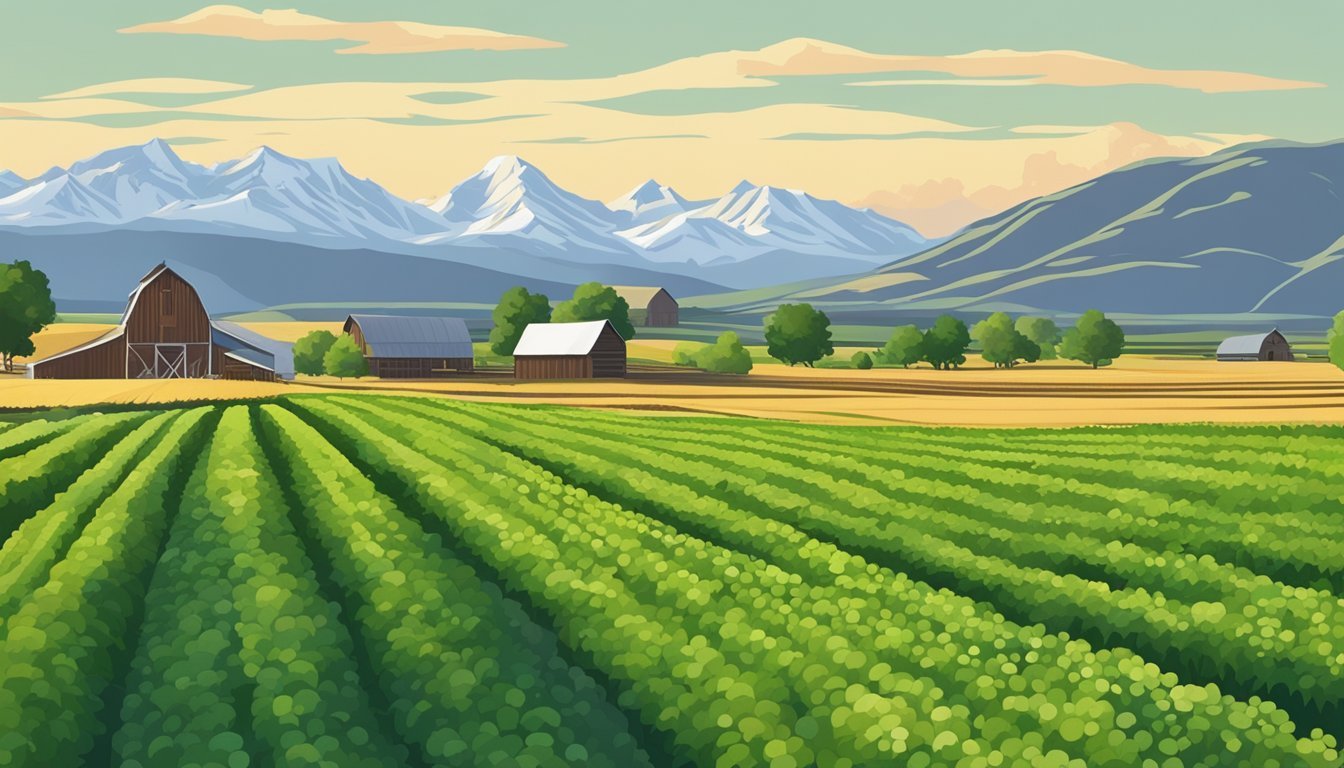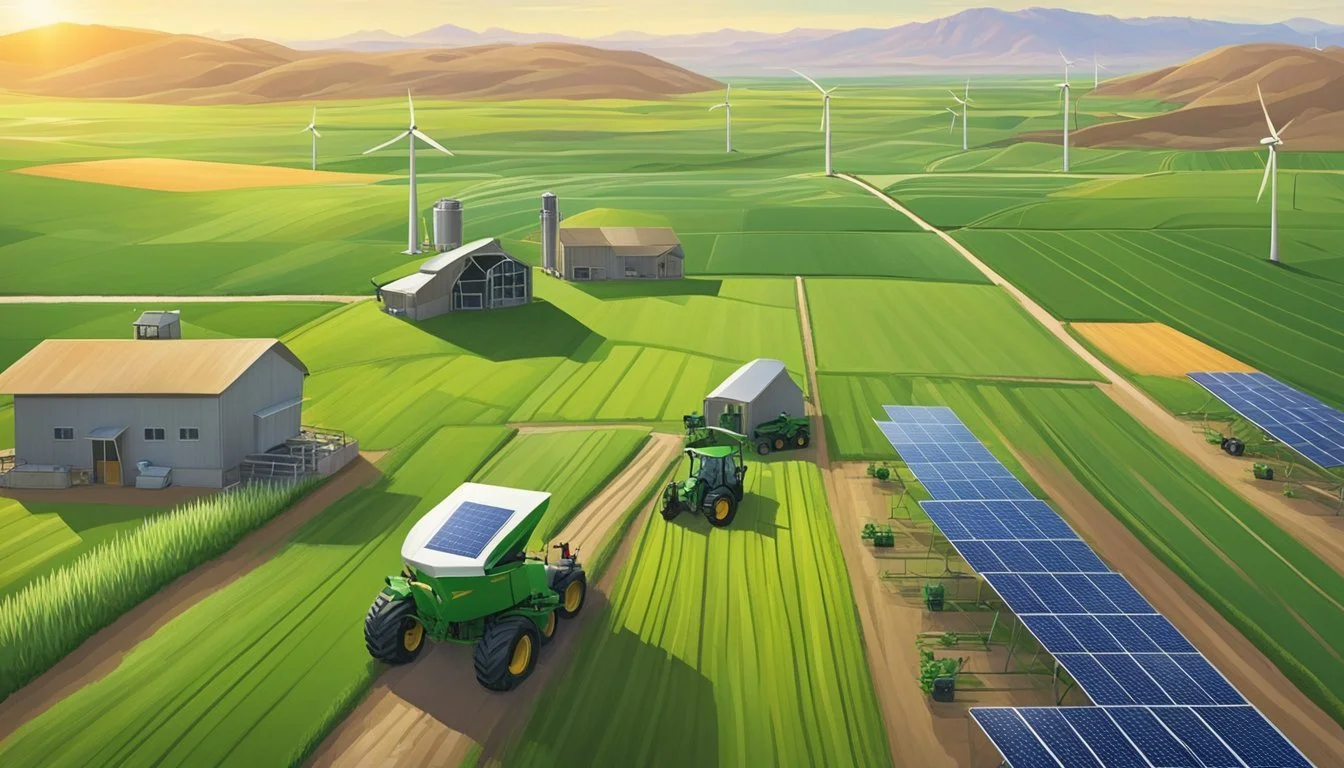Guide to Farming in Utah
Essential Tips for Successful Harvests
This Article is Part of Our State by State Farming Guide
Agriculture remains a vital part of Utah's heritage and economy, with its unique geography offering varied climates conducive to diverse farming practices. From the more than 500 century farms that have withstood the test of time to the latest generation of farmers innovating on smaller plots of land, the state of Utah provides robust opportunities for farming. Its agricultural landscape is characterized by resilience and adaptability, where irrigated fields turn the desert green and where high-altitude valleys provide a cool respite for a variety of crops.
Farming in Utah is not just about maintaining traditions but also about embracing new methods that enhance sustainability and productivity. With resources like the Utah Department of Agriculture and Food and Utah State University Extension, farmers have access to support and guidance tailored to the unique challenges of the region. These institutions offer essential services ranging from livestock health advisories to agronomic crop management and make significant contributions to ensuring that Utah's farming remains innovative and competitive.
The state's agriculture sees an amalgamation of old and new, with conventional farming practices sitting alongside organic farming initiatives and agribusiness economics. This blend ensures that Utah's agricultural sector is not just surviving but thriving, as demonstrated by the delicious fruits, vegetables, and other produce that local farms yield. The commitment of Utah's farmers to the land and community is palpable, as they continue to work tirelessly to deliver high-quality products to markets within the state and beyond.
History of Farming in Utah
Utah's farming history is marked by adaptation and innovation in the face of environmental challenges. From initial settlement to modern techniques, agriculture in Utah has undergone significant transformation.
Early Agriculture and Homesteading
In the late 19th century, Utah's agricultural landscape began shaping up with the arrival of settlers. They quickly learned that the region's arid climate and rugged terrain required more than traditional farming methods. Homesteading became common, with farmers leveraging small parcels of land. The use of water in farming was a pressing challenge, leading to early, albeit limited, irrigation practices to make the soil arable. This phase laid the groundwork for Utah's agricultural identity — one of perseverance and ingenuity.
Growth and Development Over Generations
As generations passed, farmers in Utah adopted changes to drive agriculture forward. The turn of the 20th century marked a boom in the sector. Infrastructure for irrigation expanded with the building of canals and reservoirs, increasing the efficiency of water use. The 1910s saw the establishment of the Extension Service, which was pivotal in extending the reach of agricultural knowledge and practices. Dry farming techniques, essential for crop cultivation in Utah's low-rainfall areas, also became more established during this time, reflecting the adaptability of Utah's farmers.
The sugar beet industry once flourished, indicating the shift towards commercial agriculture. However, as with many agricultural markets, it experienced a rise and fall. Despite challenges, Utah's agriculture has remained a cornerstone of its economic development, maturing alongside its urban and industrial advancements.
Climate and Soil Conditions
In Utah, farming success hinges on understanding the local climate patterns and managing diverse soil types effectively.
Adapting to Local Climate Variabilities
Utah's climate is characterized by wide temperature ranges and variable precipitation. January highs can range from 30-55°F, and temperatures may plummet below 0°F during winter. Across the state, annual precipitation fluctuates, from as little as 5 inches in the Great Salt Lake Desert to about 15 inches in the Wasatch Front. Farmers must consider these variations to optimize planting schedules and crop selection.
Key Climate Considerations:
Temperature Extremes: Preparation for both high and low temperature ranges is critical.
Precipitation Patterns: Water conservation techniques and drought-resistant crops can be advantageous due to the variability in rainfall.
Soil Management Practices
The soils in Utah vary greatly, influenced by climate, topography, and underlying geological structures. High pH soils and unique challenges such as high elevations can impact yields. Soil management in Utah requires a tailored approach to support agricultural activities, taking into account factors like soil texture, fertility, and pH levels.
Recommended Soil Practices:
Soil Testing: Regular analysis helps tailor nutrient management to specific needs.
Organic Matter: Incorporating organic matter can improve soil structure and nutrition.
Erosion Control: Minimizing soil disturbance and using cover crops can prevent erosion, a significant concern in Utah’s varied terrains.
Farmers in Utah must remain vigilant to the dynamic climate and soil conditions that can significantly affect agricultural productivity.
Types of Crops and Produce
Farming in Utah yields a diverse range of crops and produce due to its varying climate and fertile soil. From vegetables to fruits and grains, the state's agricultural output is both varied and abundant.
Vegetables Commonly Grown in Utah
The soil and climate conditions in Utah allow for a variety of vegetables to be successfully cultivated. Key vegetables include:
Tomatoes
Onions
Corn
Peppers
Lettuce
These vegetables contribute significantly to Utah's agricultural economy and are known for their quality and taste.
Fruit Cultivation and Varieties
Utah's fruit production is noteworthy, with orchards dotting the landscape. The state is known for its:
Cherries
Apples
Peaches
These fruits are chosen for their ability to thrive in Utah's unique climate and are a staple in both the local market and for export.
Grains and Other Staple Crops
Grains also play a critical role in Utah's farming landscape. Important staple crops include:
Wheat
Barley
Oats
These grains are essential for both human and animal consumption and form the backbone of the state's grain production. The success of these crops is a testament to the effective farming techniques and favorable conditions found in Utah.
Livestock and Dairy Farming
Utah's livestock and dairy farming are cornerstones of the state's agricultural output, with most counties reporting livestock as the dominant sector. The industry thrives on a variety of animal husbandry practices, contributing significantly to the economy.
Beef and Meat Production
In Utah, beef cattle production is an integral component of the agriculture sector. These animals predominantly graze on the state's diverse landscapes, finding sustenance from the grasslands and utilizing the available water resources. The beef sector is characterized by its adherence to sustainable grazing practices to ensure the health of both cattle and the environment.
Milk, Cheese, and Dairy Industry
The dairy industry in Utah is concentrated in the irrigated valleys to the west and north of Salt Lake City. It boasts a robust infrastructure for the production of milk and cheese products. Dairy farming necessitates intensive management, with local farmers leveraging technologies and efficient practices to enhance milk quality and safety. The state's dairy farms not only supply milk but also contribute to a growing cheese industry, which is gaining prominence for its quality products.
Organic Farming and Sustainable Practices
Utah's agricultural scene is increasingly embracing organic farming and sustainable practices. Farmers across the state are adopting systems that balance the environmental, economic, and social pressures to produce high-quality, healthful food.
Certified Organic Farms
In Utah, certified organic farms must adhere to both state and federal regulations. Certified organic implies that:
The farm follows site-specific management practices.
These practices combine cultural, biological, and mechanical processes.
They must comply with the National Organic Standards during the transition phase.
Farmers need to provide a detailed operation description and documentation of their practices.
The process of becoming certified organic is a commitment. It may take a few years for farms to peak in productivity as they adjust to organic methods.
Sustainability in Agriculture
Sustainability in agriculture is a core aim for Utah's farmers, venturing beyond traditional organic methods. Sustainable practices focus on:
Minimizing environmental impact, maintaining the health of the land.
Enhancing food quality by using organic materials and conserving natural cycles.
Adopting regenerative practices ensures the long-term health of both the livestock and the land.
Utah's agriculturists are leading examples of sustainable farming with a mindful approach towards resource utilization, highlighting the importance of supporting and revitalizing the land they cultivate.
Agricultural Education and Support
In Utah, the emphasis on agricultural education is significant, providing a solid foundation and support for individuals pursuing farming as a career. Resources and classes dedicated to agriculture help foster knowledge and practical skills necessary for success in the industry.
Utah State University Extension Services
Utah State University Extension offers expert services in both agriculture and natural resources. The Extension's programs are tailored to provide support at every stage of farming, from beginner to advanced practices. They offer a range of resources that include:
Agribusiness & Ag Economics: Guidance on the economic aspects of farming.
Animal Health: Vital information on maintaining livestock well-being.
Irrigation: Best practices for water management.
Rural Tax Education: Help with financial aspects of farming.
Through direct classes and educational materials, they ensure that farmers have up-to-the-minute, research-based knowledge to make informed decisions.
Classes and Resources for New Farmers
New farmers in Utah have access to various classes and resources that provide them with the necessary knowledge to start and sustain successful farming ventures. Key offerings include:
Agricultural Education: Introductory and advanced courses in agriculture.
Certified Organic Farming: Classes on organic farming methods.
Farm Safety: Training to ensure safety on the farm.
Livestock and Poultry Production: Education on raising animals for food production.
These resources are designed to make agricultural education accessible and to support new farmers in developing a comprehensive understanding of modern farming techniques.
The Role of Agriculture in Local Economy
Agriculture remains a cornerstone of Utah's local economy, not only shaping the state's food systems but also as a robust economic engine driving job creation and commerce.
Impact on Local Markets and Food Systems
Agriculture in Utah significantly influences local markets and food systems. It provides the backbone for a network of local food distribution that sustains both urban and rural communities with fresh produce. Local farms and agribusinesses play a pivotal role in maintaining the availability of healthy, locally sourced food. This direct farm-to-market pipeline not only supports Utah's food security but also promotes sustainability within the community, ensuring that consumers have access to fresh, quality products.
Job Creation and Economic Benefits
The economic contributions of agriculture to the local Utah economy are substantial. The sector not only accounts for 15% of the state's economic output but also provides employment to more than 66,000 individuals. Detailed economic reports highlight that the combined efforts of food production, processing, and related agricultural services generate a total economic impact exceeding $71.3 billion.
Total Jobs: 438,644
Total Wages: $19.9 billion
Total Taxes: $5.8 billion
Exports: $1.5 billion
These figures underscore agriculture’s role as a key economic driver, reinforcing its importance in not only the creation of jobs but also in the generation of wages and taxes contributing to Utah's fiscal strength.
Modern Challenges and Opportunities
The landscape of agriculture in Utah is shaped by modern challenges such as market fluctuations and the impact of the pandemic, but it also presents opportunities through advancements in technology and innovation.
Adapting to Changing Market Demands
Utah farmers are responding to evolving consumer preferences and market demands, necessitating a shift in crop selection and farming practices. They face the challenge of balancing crop yield with sustainable farming methods. Demand for locally-sourced and organic produce is increasing, prompting Utah farmers to diversify their crop production to include a broader variety of fruits and vegetables.
Innovation and Technology in Farming
The introduction of cutting-edge technologies is offering Utah farmers opportunities to increase efficiency and productivity. They are implementing precision agriculture tools, such as drones and sensor-based irrigation systems, to optimize water use—a crucial aspect considering Utah's water scarcity issues. Biotechnology also affords the opportunity to develop crop varieties that are more resilient to the challenges posed by the state's climate.
Coping with the Effects of the Pandemic
The pandemic has posed significant challenges for Utah's agricultural sector, but it has also accelerated the adoption of digital platforms for direct-to-consumer sales. Farmers have shifted towards online marketplaces and delivery systems to maintain sales and meet consumer demand. Adapting to these changes has been crucial in sustaining the farming community during these times.
Community Involvement and Agriculture
In Utah, community involvement in agriculture is exemplified through robust Community Supported Agriculture (CSA) Programs and vibrant agricultural events, including farmers markets. These initiatives strengthen the bond between consumers and local farmers, fostering a sustainable food system and a sense of community through active participation and support.
Community Supported Agriculture (CSA) Programs
Community Supported Agriculture (CSA) programs are integral to Utah's agricultural community. They allow consumers to purchase a "share" of a farm's expected harvest. Here's how it typically works:
Payment Structure: Consumers pay upfront for the season.
Weekly Shares: In return, they receive weekly allotments of fresh, locally-grown produce during the farming season.
This model benefits local farmers by providing them with early season capital, reducing the financial risks inherent in farming. For consumers, CSAs offer access to fresh produce and a direct connection to the people who grow their food.
Agricultural Events and Farmers Markets
Farmers Markets serve as a critical nexus between local agriculture and the community. Key aspects include:
Locale: Often hosted in accessible locations, such as city centers or community parks.
Timing: They are usually held on a weekly basis, providing a regular opportunity for consumers to buy fresh, local products.
Variety: Markets feature a range of goods from multiple local producers, including fruits, vegetables, meats, and artisanal foods.
Farmers markets not only support the local economy but also serve as social events that bring the community together. They are places where people can learn about food sources, engage with farmers, and participate in the local food system.
Resources and Guidance for Utah Farmers
The agricultural landscape in Utah offers a diversity of resources and support programs dedicated to assist farmers and ranchers in sustaining and improving their operations.
Agriculture Producers' Associations
Utah Department of Agriculture and Food (UDAF): An integral entity providing safety and support to the state's agricultural community. It plays a role in ensuring a secure food supply and represents a source of employment within the sector.
Utah Farm Bureau: A leading voice for farmers, focusing on issues like water resource management and the future of farming in Utah in the face of challenges such as drought and population growth.
Governmental Agencies and Support Programs
Natural Resources Conservation Service (NRCS): NRCS administers the Agricultural Management Assistance Program, which includes an organic certification cost-share and risk mitigation through insurance cost-share programs.
Grants and Resources: Farmers have access to various resources including programs and grants tailored to improve their productivity and mitigate risks, as outlined by the Utah Agriculture Toolbox document.









